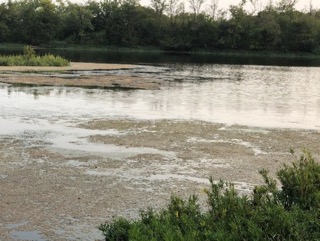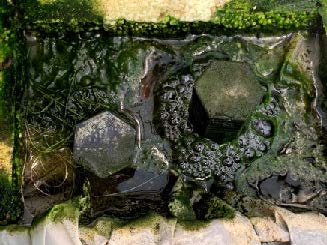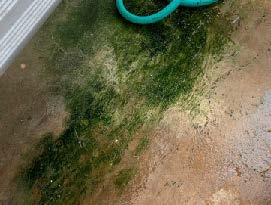Algae Control for Greenhouse Production
Introduction
Algae is the general term for a diverse group of photosynthetic eukaryotic organisms, ranging from unicellular microalgae to multicellular giant kelp. Since there is not a commonly accepted definition, algae are considered a polyphyletic group, meaning they are grouped solely on similar characteristics. Algae lack the structures such as xylem, phloem, roots and leaves found in land plants. They derive energy from photosynthetic activity, such as converting light into energy, or organic carbon uptake. While not classified as “true plants” like the higher plants of Kingdom Plantae, algae often are considered lower plants due to their photosynthetic characteristics.
Types of Algae
Beginning in the 1830s, algae were classified in groups based on color: red, brown, and green. More recently, the group has been divided to seven major types. These groups are Euglenophyta, Chrysophyta, Pyrrophyta, Chlorophyta, Rhodophyta, Paeophyta and Xanthophyta. The divisions are based on distinct sizes, functions and colors. In most ponds and irrigation systems, members of Chlorophyta, Chrysophyta, and cyanobacteria are usually the culprits in clogging pumps or creating mats on the surface of the water (Figure 1).
Figure 1. Algae growing in a pond used for irrigation.
Euglenophyta are simple freshwater and marine algae. Most members of Euglenophyta use photosynthesis, though some members can feed on organic material when lacking sufficient sunlight. Some main characteristics are an eyespot, flagella (a long whip-like tail) and organelles such as chloroplasts, nuclei and vacuoles.
Chrysophyta are commonly called golden-brown algae and include diatoms. This type of algae is the most abundant form of unicellular algae. Diatoms are more common than golden-brown algae and consists of most forms of plankton in the ocean. Unlike many forms of algae, diatoms have silica-based shell. Golden-brown algae are similarly productive, usually known as nanoplankton.
Pyrrophyta is home to unicellular algae often called ‘fire algae.’ Known for its red color, this alga is famous for toxic algae blooms that turn the ocean red and are commonly called a red tide. The neurotoxins produced by the algae can cause muscle function disruption in humans and other animals.
Chlorophyta are the most well-known freshwater algae, as it is commonly called green algae. Most multicellular species form colonies ranging from the smallest at four cells to larger colonies with several thousand cells. Notable types of green algae include sea lettuce, horsehair algae and dead man’s fingers.
Rhodophyta, or red algae, are tropical marine algae. Red algae prefer to grow on solid surfaces such as coral reefs. This group also forms many different types of seaweed.
Paeophyta, known as brown algae, is the largest form of algae. Giant kelp and rockweed are two significant members of this group. These marine algae often are distinguished by their anchoring organ and air pockets to promote buoyancy.
Lastly, Xanthophyta is the smallest group, consisting of only 450 to 650 species. These yellow-green algae are missing certain pigments in their chloroplasts, causing them to appear a lighter color. Colonies of a few cells are often found in freshwater, but also can be found in marine and wet soil environments.
Algae are not limited only to the plant kingdom. A very serious type of algae, blue-green algae or cyanobacteria, causes problems, such as algal blooms. Cyanobacteria is structurally similar to bacteria but gains energy from light and photosynthesis. Blue-green algae requires sunlight, calm, warm water and an abundance of phosphorous and nitrogen.
Uses for Algae
Though more well known for causing problems, algae have many uses from food additives to biofuels and more. Alginic acid, derived from brown algae, is often used as a gelling agent, as well as in biotechnology as a component to immobilize and encapsulate cells. Edible algae, such as spirulina and chlorella, have great amounts of necessary vitamins and minerals, as well as protein. Algae are even used as carbohydrates for feedstock. These versatile microorganisms are utilized in fertilizers, pollution scrubbers, polymers, pigments and biofuels. Recent research is looking into their role in hydroponic plant co-cultivation as well.
Problems with Algae
Algae often comes in three forms: mats, blooms and plant-like formations. Mats form when unicellular algae colonize into large swaths and coat surfaces in the water, often starting at the edges of ponds or on the bottom of tanks. These mat-like structures tend to be prone to die-offs, which is when large amounts of algae die at the same time. The decomposition of the algae causes oxygen depletion, causing what are known as “dead spots” in the body of water. Algae mats can also produce toxins that can enter the water column, as well as prevent light from reaching the aquatic habitat below the mat. These mats tend to be especially difficult to manage within hydroponic systems and pond habitats (Figure 2).
Figure 2. Algae growing in an Ebb and Flow hydroponic system.
Algal blooms come in the form of microalgae. Notorious blooms, such as the ‘red tide’ caused by fire algae, often produce toxins and cause mechanical disruptions. Harmful algae blooms (HABs) are usually associated with mass mortality events of marine animals and various types of shellfish poisonings.
In agricultural systems, algae can cause problems in surface ponds, reservoirs, hydroponic and aquaponic systems and irrigation and cooling equipment (Figure 3). Shallow, stagnant water and high levels of nutrients can promote algal growth. This growth can cause clogging of irrigation systems and pumps, as well as competition with crops and attracts pests such as shore flies and fungus gnats.
FIgure 3. Algae growing beneath a mist bench that can lead to a slipping hazard as well as a site that harbors fungus gnats.
Prevention and Control
Depending on the circumstances, prevention and control of algae can range in difficulty from simple to complex. Preventing algae from growing in the first place is much easier than attempting to eradicate the plant later. Not all methods work for any given species of algae, but there are some measures that can be taken to reduce algae in bodies of water.
Preventative Measures
There are several ways to prevent algae from growing in your greenhouse, soilless production system or irrigation pond.
- Introduce aeration into your pond or water feature – Algae tends to grow in stagnant water, so increasing water movement can prevent algae mats from forming.
- Make sure not to bring any foreign or invasive plants, plant parts or water into your water system – Rinse and sanitize any objects that enter the water. This prevents any plants from other waters from infecting your water or hydroponic system.
- Use phosphorus-free fertilizers to reduce runoff of nutrients into your water – Excess nutrients cause algae to grow in water; phosphorus particularly causes algae to grow in surplus. Decreasing fertilizer runoff will decrease the ability of algae to grow in the water or on systems like cool cell pads.
- Agricultural ponds should have depths greater than 3 feet – Shallow water is a magnet for algae growth.
- Cover any hydroponic tanks with lids or black plastic – Preventing light from reaching the surface of the nutrient solution can prevent algae growth.
- Use of UV light clarification – UV light clarification can be effective in ponds, irrigation water and hydroponic systems to eliminate single-celled algae. It is not effective on any algae that will not travel through the light.
- Turn off water – Turn off mist benches or mist zones when not in use and clean drains so puddling does not occur.
- Allow equipment to dry – Let cool cell pads dry between use and keep fertilizer water out of system. Use ventilation to lower humidity levels and horizontal air flow fans to keep surfaces dry.
- Sanitation – Surfaces known to have algae growing on them (irrigation tanks, drip emitters, hydroponic media and rafts, trays, etc.) should be sanitized between each crop. Walls and floors can be pressure washed and any weeds should be removed. A chlorine dioxide product, Selectrocide™, can be injected into irrigation lines, however that water should not be used to irrigate crops due to phytotoxicity or plant damage. Use of ½ cup of 3% hydrogen peroxide per 100 gallons (378 liters) of water can be helpful for irrigation systems.
- Well-drained media – Use media with greater amount of bark or perlite to increase drainage on longer term or stock plant production.
No method of prevention is 100% effective. However, it is possible to help reduce the likelihood of algae growth.
Mechanical Control
- Rake/dredge the pond of algae – Physical removal of the algal mat by raking is one method to remove the algae, though it will have to be repeated several times during peak growing season.
- Sanitation of surfaces – Clean hydroponic floats between growing cycles can help lessen algae. Physical removal of the debris using a jet attachment on a water hose or power washer, then application of a chemical cleaner, such as a 1:100 bleach solution (approximately 1.3 oz. of bleach to 1 gallon of water) or soak for at least 15 minutes in a water-and-vinegar solution (which will sanitize but not sterilize) can sanitize floats and equipment and help reduce algae between runs of hydroponic crops. Floors and benches around mist systems should be cleaned weekly.
- Mechanical harvest of vegetation – Mechanical harvesters are practical for larger bodies of water and are a major investment. Similar to lawn mowers, mechanical harvesters can successfully cut pathways in aquatic vegetation and help to reduce numbers.
Chemical Control
- Barley straw – Barley straw is one of the oldest and environmentally friendly methods of reducing algae. Algicidal compounds are released as the straw degrades. However, results are not reliable or repeatable, nor is barley straw effective on all forms of algae. Recommended rates include two to three bales of straw per surface acre and two to three times that dose in muddy ponds and have a high population of algae. Barley straw is best used before algae blooms begin (fall through early spring). When applied to cold water, barley straw may take six to eight weeks to be effective, while application to warmer water [70 F (21.1 C) and above] may take as little as one to two weeks to gain effectiveness. Barley straw remains in the system for approximately six months. The straw is not recommended for ponds with substantial amounts of fish or hydroponic systems, as degradation deoxygenates the water, causing mass die-offs of fish and low dissolved oxygen content for hydroponic systems.
- Algicides and aquatic herbicides – Hydrogen peroxide, hydrogen dioxide, peroxyacetic acid, sodium carbonate peroxyhydrate, octanoic acid, quaternary ammonia, and copper are common ingredients found in algicides labeled for greenhouse use (Table 1). Most are labeled for use on greenhouse surfaces, equipment, benches and pots and should not be mixed with other pesticides or fertilizers, nor directly applied to some crops as phytotoxicity can occur. Do not pour directly onto fish or add an overabundance of hydrogen peroxide, as that can damage the fish severely. For hydroponic systems, rates vary with specific crops and most are relatively untested and can cause fluctuations in the pH. Be sure to check the label of the product being used for appropriate rates and multiple applications are generally needed for control.
To effectively utilize algicides and aquatic herbicides for irrigation ponds, one must first determine what type of algae is present, then calculate the acreage and water volume of the irrigation pond. For identification, see Identifying and Managing Aquatic Vegetation in further reading. To calculate pond acre-feet, multiply the surface area by the average depth. For example, a pond with a surface area of half an acre and an average depth of 10 feet contains 5 acre-feet (0.5 acre X 10 feet = 5 acre-feet). Algicides only work on contact, so even application at the correct rate is imperative. Use in hydroponics is relative untested, but not recommended as it can cause fluctuations in pH. Be sure to check the label of the product for appropriate rates and note that multiple application may need to be made. See Table 2 for common algicides and aquatic herbicides for ponds.
Biological Control
- Grass carp – In some systems, it may be beneficial to add a biological control such as grass carp. These fish can eat the algae and tie up some excess nutrients in the water. It is recommended to stock carp at five to nine fish per acre for partial control and 10 to 12 fish per acre for total control of aquatic plants. Grass carp are not ideal for irrigation ponds since they can indirectly increase turbidity and can escape through as little as 3 inches of water through any overflow or spillway pipeline.
- Reduce outside sources of nutrients – By reducing wildlife, such as geese, lawn fertilizer run off, domesticated animals and livestock excrement runoff, and septic tank runoff, the nutrient content and, thus, algae concentration in the water can be reduced as well.
Further Reading
Lembi, C. Identifying and Managing Aquatic Vegetation. Purdue Extension Program. APM-3-W.
Federation of Ontario Cottagers’ Association. n.d. Algae.
Camberato, D.M. and R.G. Lopez. 2016. Controlling Algae in Irrigation Ponds. Purdue Extension Program HO-247-W.
Raudales, R. 2016. Algae on the Nutrient Solution and Surfaces. e-Grow Edible Alert.
Pundt, L. 2021. Weeds, Algae and Liverworts. In: Pundt, L., R.E. Raudales, and C.
Smith (eds.). New England Greenhouse Floriculture Guide.
Table 1. Algicides and their characteristics for greenhouse use (Punt, 2021).
| Common Name | Trade Name | Target Application | Comments |
|---|---|---|---|
| hydrogen dioxide & peroxyacetic acid | Jet-Ag® | Use on greenhouse surfaces, equipment and greenhouse irrigation systems. | Strong oxidizing agent. Works by surface contact. Use on greenhouse structures, benches, floors. Do not use at higher than recommended rates as leaf burn may result. See label for specific plant applications. Spot test before treating large numbers of plants. Organic. |
| hydrogendioxide & peroxyacetic acid | ZeroTol® 2.0 | Use on greenhouse structures, benches, walkways. Chemigation. | Strong oxidizing agent. Works by surface contact. All surfaces must be wet before treatment. Use on greenhouse structures, benches, pots, floors. See label for rate if areas are not precleaned to remove organic deposits. Heavy algal growth may have to be scrubbed off after application. Do not use at higher than recommended rates as leaf burn may result. See label for specific plant applications. Organic. |
| hydrogen peroxide & hydrogen dioxide | PERPose Plus™ | Use on greenhouse structures, benches, walkways. Chemigation. | Strong oxidizing agent. Thoroughly wet all surfaces. Organic |
| hydrogen peroxide & peroxy-acetic acid | SaniDate®12.0 | Use on greenhouse surfaces, equipment. Chemigation. | Strong oxidizing agent. Clean surfaces before treatment. Thoroughly wet all surfaces. Organic. |
| hydrogen peroxide & peroxyacetic acid & octanoic acid | X3™ | Use on greenhouse structures and walkways. Chemigation. | Strong oxidizing agent. Clean surfaces before treatment. Allow solution to remain wet for 10 minutes. Reapply as needed for control. Not for use in greenhouses where food crops are grown. |
| quaternary ammonium compound | Green-Shield®11 | Use on greenhouse glass or walkways. | Pre-clean heavily soiled areas. Treated surfaces must remain wet for 10 minutes. |
| quaternary ammonium compound | Physan 20® | Use on greenhouse walkways and benches. | Preclean all surfaces. Thoroughly wet all surfaces for at least 10 minutes. Not for use in greenhouses where food crops are grown. See label for rates and specific plant applications. |
| quaternary ammonium compound | KleenGrow™ | Use on greenhouse surfaces and walkways. | Thoroughly clean all surfaces and saturate for 10 minutes. Ventilate closed spaces. Reapply every 14 days to keep algae from regrowing. |
| sodium carbonate peroxyhydrate | Green Clean® Pro | Use on walkways and weed control mats under benches. | Strong oxidizing agent. Treat when algal growth first appears. Non-target plants suffer contact burn if undiluted granules are accidentally spilled on them. Organic. |
Table 2. Algicides and aquatic herbicides for ponds (Lembi, 2019).
| Material | Aquashade | Copper Sulfate | Cutrine Plus®, Cutrine Ultra®, Earthtec®, K-Tea® | GreenClean |
|---|---|---|---|---|
| Active Ingredient | 12.6% acid blue and 1.04% acid yellow 23 | Copper sulfate in varying percentages | Elemental copper from mixed copper ethanolamine complexes | Sodium carbonate peroxyhydrate (sodium carbonate + hydrogen peroxide) |
| Effectiveness(E)= excellent(G)= good(F)= Fair | Filamentous (E) Branched (E) Planktonic (G) | Filamentous (E) Branched (E) Planktonic (E) | Filamentous (E) Branched (E) Planktonic (E) | Filamentous (F) Branched (G) Planktonic (E) |
| Relative Cost | $$$ | $ | $$$$$ | $$$$$ |
| Approximate Rate | 1 quart/acre-foot | 0.68 to 0.52 pounds per acre-foot | 0.6 to 3.0 gallons per acre-foot, depending on product | 3 to17 pounds per acre-foot |
| Mode of Action | Blocks portion of spectrum necessary for photosynthesis | Disrupts cell membranes | Disrupts cell membranes | Likely disrupts cell membranes and walls |
| Details | Use early in season before extensive growth. May not work well in shallow areas less than 2 to 3 feet deep. | Less effective in hard water (high Ca and Mg content). Toxic to fish at low pH. Best when water temperatures are above 60 F. | Chelated copper compounds prevent copper from precipitating out of solution in hard water. Best when water temperatures are above 60 F. | Best where water pH range is 6.8 to 7.8. Works at all water temperatures, but faster at warmer temperatures. |
| Restrictions | No Water Restrictions | No Water Restrictions | No Water Restrictions | No Water Restrictions |



